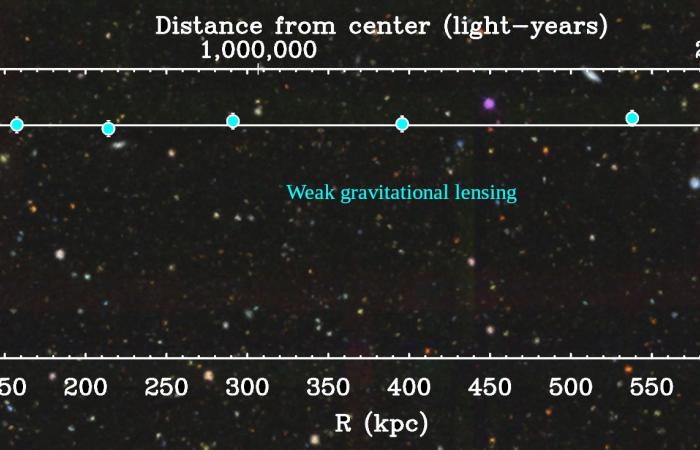The research group study which also includes the National Institute of Astrophysics calls into question the generally shared cosmological models on the mystery of dark matter. Published today on arXiv and in print on The Astrophysical Journal Letters, the result adds an important piece to the resolution of the enigma of dark matter – the nature of which is one of the great questions of modern astrophysics, still unanswered – potentially calling into question generally shared cosmological models. The research team behind the study demonstrated that the rotation speeds of galaxies remain unexpectedly constant even at very large distances from their centerconfirming the predictions of the modified Modified Newtonian Dynamics (Mond) theory of gravity, which does not contemplate the presence of dark matter in the universe.
Graph illustrating the observations reported in the article: the red points show the rotation curve of the galaxy UGC 6614 using “classic” observations of the gas kinematics, while the light blue points show the new statistical result using the weak lensing technique. Credit: T. Mistele et al. (2024)
In this work, a new technique was developed that allows the so-called rotation curves of galaxies – that is, the rotation speeds of galaxies from their center – to be measured up to very large distances, equal to approximately two million and 500 thousand light years. The technique used exploits the phenomenon of weak gravitational lensing (weak gravitational lensing). The implications of this discovery could potentially be very broad, leading to redefining our understanding of dark matter also through alternative cosmological theories.
The phenomenon of gravitational lensing was predicted by Einstein’s theory of general relativity and occurs when a massive object, such as a cluster of galaxies or even a single massive star, bends the path of light coming from a distant source with its gravitational field . This bending of light occurs because the mass of the object deforms the fabric of spacetime surrounding it.


Federico Lelli (Inaf), expert in the dynamics of galaxies and galaxy systems (groups and clusters) as test beds for both dark matter theories and alternative gravitational theories. Credits: Inaf
«We used the technique of weak gravitational lensing to statistically measure the average “rotation curve” of galaxies of different masses, reaching very large distances from the center”, he explains Federico Lelli, first researcher at INAF in Arcetri and co-author of the study. «We find that the rotation curves continue to remain flat for hundreds of thousands of light years, possibly up to a few million light years: this is surprising, because at such distances one would expect to have reached the “edge” of the halo. dark matter, so the rotation curves should start to show a Keplerian decrease, but instead they remain flat.”
Rotation curves measure the speed that a celestial body (such as a star or a cloud of gas) at a certain distance from the galactic center must have to remain in a circular orbit around the galaxy. The presence of dark matter in galaxies was deduced by studying the rotation curves in the years between 1970 and 1980. It is believed that the rotation curves of galaxies should decrease as the distance from the center of the galaxy increases. According to Newtonian gravity, stars at the outer edges of the galaxy should be slower due to less gravitational pull. Since this hypothesis does not correspond to observations, scientists have hypothesized the presence of so-called dark matter, which would not emit electromagnetic radiation but would only be detectable through the effects of its gravitational field. Even assuming the existence of dark matter, however, at a certain point its effect should weaken with distance, and therefore the rotation curves of galaxies should not remain constant indefinitely.
The study casts doubt on this hypothesis, providing a surprising revelation: the influence of what we call dark matter extends far beyond previous estimates, that is, for at least a million light years from the galactic center. Such a large force could paradoxically indicate that dark matter, as understood so far, may not exist at all.
“This discovery calls into question existing models,” he says Tobias Mistele of Case Western Reserve University and first author of the study, «suggesting that either very large dark matter halos exist or that we need to radically revise our understanding of gravitational theory».
«We used these data», adds Lelli, «to study the Tully-Fisher relationship – a scaling law between the baryonic mass (that of which stars and gas are made) and the rotation speed of galaxies – finding that the same law persists when we use speeds measured at very large distances. This result is not at all obvious, since at such distances the rotation speed is determined entirely by dark matter, not by baryonic matter. The observations allow us to reach enormously large distances from the galactic center, about twenty times greater than those achieved with classical techniques. To our surprise, we found that the rotation curves remain almost perfectly flat – in other words, the velocity remains constant – up to the greatest distances we are capable of reaching.”
This type of study intends to clarify the nature of dark matter, or whether these gravitational phenomena are due to a new type of “invisible” elementary particle yet to be discovered, or whether there is a need to review the gravitational laws of Newton and Einstein .
«This result does not have an obvious explanation in the standard cosmological context of Lambda Cold Dark Matter (Lambda-Cdm) and could have to do with the environment of the galaxy», specifies Lelli «i.e. with the distribution of the smallest dark matter halos which is believed to orbit the main halo. To limit this effect, in fact, we have selected our galaxies to be as isolated as possible.”
Flat rotation curves up to large radii had already been predicted by the modified Mond theory of gravity, proposed by physicist Mordehai Milgrom in 1983 as an alternative to dark matter. «Our observations are in agreement with what Mond predicted more than 40 years ago», concludes Lelli.
Further studies are now necessary to clarify the compelling cosmological puzzle and write a new page in the history of modern astrophysics.
To know more:
Watch the video service on MediaInaf TV:







